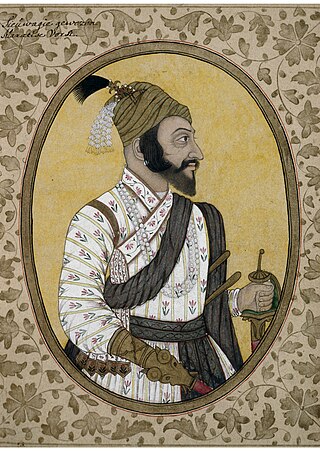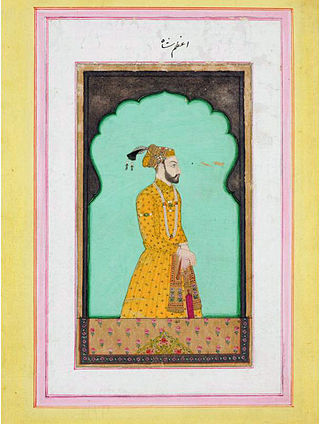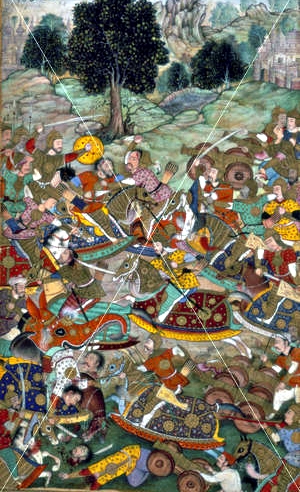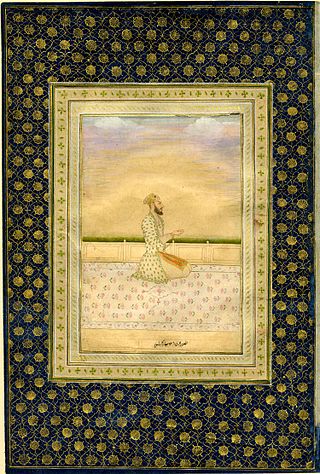Related Research Articles

Shivaji I was an Indian ruler and a member of the Bhonsle Maratha clan. Shivaji carved out his own independent kingdom from the declining Adilshahi sultanate of Bijapur which formed the genesis of the Maratha Empire. In 1674, he was formally crowned the Chhatrapati of his realm at Raigad Fort.

'Dara Shikoh,also known as Dara Shukoh, (20 March 1615 – 30 August 1659)was the eldest son and heir-apparent of the Mughal emperor Shah Jahan. Dara was designated with the title Padshahzada-i-Buzurg Martaba and was favoured as a successor by his father and his elder sister, Princess Jahanara Begum. He had been given the title of 'Sultan Buland Iqbal' by Shah Jahan. In the war of succession which ensued after Shah Jahan's illness in 1657, Dara was defeated by his younger brother Prince Muhiuddin. He was executed in 1659 on Aurangzeb's orders in a bitter struggle for the imperial throne.

Mirza Qutb-ud-Din Muhammad Azam, commonly known as Azam Shah, was briefly the seventh Mughal emperor from 14 March to 20 June 1707. He was the third son of the sixth Mughal emperor Aurangzeb and his chief consort Dilras Banu Begum.

The Battle of Khanwa was fought at Khanwa on March 16, 1527. It was fought between the invading Timurid forces of Babur and the Rajput Confederation led by Rana Sanga for suprermacy of Northern India. The battle was a major event in Medieval Indian history although Timurids won at Panipat but at the time, the sultanate at Delhi was a spent force that was long crumbling. To the contrary Mewar kingdom, under the able rule of Rana Sanga, had turned into one of the strongest powers of northern India. Therefore the battle was among the most decisive battles in the Mughal conquest of northern India.

Mirza RajaMan Singh I was a Kachhwaha Rajput prince who became the 24th Maharaja of Amber from 1589 to 1614 and the Subahdar of Bengal for three terms from 1595 to 1606. He served in the Imperial Mughal Army under Emperor Akbar. Man Singh fought sixty-seven important battles in Kabul, Balkh, Bukhara, Bengal and Central and Southern India. He was well versed in the battle tactics of both the Rajputs as well as the Mughals. He is commonly considered to be of the Navaratnas, or the nine (nava) gems (ratna) of the royal court of Akbar.

Sir Jadunath Sarkar, was a prominent Bengali historian and a specialist on the Mughal dynasty.
A Subah was the term for a province (state) in the Mughal Empire. The term was also used by other polities of the Indian subcontinent. The word is derived from Arabic and Persian. The governor/ruler of a Subah was known as a subahdar, which later became subedar to refer to an officer in the Indian Army and Pakistan Army. The subahs were established by badshah (emperor) Akbar during his administrative reforms of years 1572–1580; initially they numbered to 12, but his conquests expanded the number of subahs to 15 by the end of his reign. Subahs were divided into Sarkars, or districts. Sarkars were further divided into Parganas or Mahals. His successors, most notably Aurangzeb, expanded the number of subahs further through their conquests. As the empire began to dissolve in the early 18th century, many subahs became effectively independent, or were conquered by the Marathas or the British.
Mirza Muhammad Akbar was a Mughal prince and the fourth son of Emperor Aurangzeb and his chief consort Dilras Banu Begum. He went into exile in Safavid Persia after a failed rebellion against his father in the Deccan.

Dilras Banu Begum was the first wife and chief consort of Emperor Aurangzeb, the sixth Mughal emperor. She is also known by her posthumous title, Rabia-ud-Durrani. The Bibi Ka Maqbara in Aurangabad, which bears a striking resemblance to the Taj Mahal, was commissioned by her husband to act as her final resting place.

Jahanzeb Banu Begum, popularly known as Jani Begum, was a Mughal princess and the chief consort of Muhammad Azam Shah, the heir-apparent to Emperor Aurangzeb, who briefly became Mughal emperor in 1707.

Mirza Muhammad Sultan was the eldest son of Mughal emperor Aurangzeb and his second wife Nawab Bai. His younger brother Muazzam later became Emperor as Bahadur Shah I in 1707.

Muhammad Bidar Bakht was a Mughal prince. His father, Muhammad Azam Shah, briefly reigned as Mughal emperor in 1707. Bidar was noted for being a gallant, skilful and successful general and was regarded as the most able Mughal prince of his time. He was the favourite grandson of Emperor Aurangzeb.
Zainabadi Mahal was a concubine of Mughal emperor Aurangzeb.
Khulasat-ut-Tawarikh is a Persian language chronicle written by Sujan Rai in the Mughal Empire of present-day India. It deals with the history of Hindustan, and also contains details about the contemporary Mughal Empire. The author completed the work in 1695 CE, during the reign of Aurangzeb. An insertion about Aurangzeb's death was later added to the original copy by a transcriber.
Handia is a village in Madhya Pradesh state of India. It is located in the Handiya block and tehsil of the Harda district. Handia is located on the left bank of the Narmada river; Nemawar is located on the opposite side, which belongs to Dewas district.
Nur-un-Nissa Begum was the first wife and chief consort of Mughal emperor Bahadur Shah I.

The Ajmer Subah was one of the original 12 subahs that comprised the Mughal Empire after the administrative reform by Akbar. Its borders roughly corresponded to modern-day Rajasthan, and the capital was the city of Ajmer. It bordered the subahs of Agra, Delhi, Gujarat, Thatta, Multan, and Malwa.

The Subah of Lahore was a province of the Mughal Empire encompassing the central Punjab region, now divided between Pakistan and India. It was created as one of the original 12 Subahs of the Mughal Empire under the administrative reforms carried by emperor Akbar in 1580. The province ceased to exist after the death of its last viceroy, Adina Beg in 1758, with large parts being incorporated into Durrani Empire.

The Capture of Agra Fort ended a month-long siege by Suraj Mal on 12 June 1761. After a one month siege of Agra the Mughal army, led by Mirza Fazilka Khan, surrendered to the Jat army. The Jat possessed himself of all the wealth of the Mughal Empire and thus became one of the richest man on the planet. The Jats seized the old capital of Mughal Empire. It remained in possession of Bharatpur State rulers until 1774.
References
- 1 2 3 4 5 6 7 8 9 10 Jadunath Sarkar (1901). India of Aurangzib. Kinnera. pp. xv–xcvi.
- ↑ "Chahar Gulshan". Indian History - Vol 7, No. 542. pp. 17–18.
- 1 2 3 4 5 6 Abha Singh (April 2014). "Book Review: Rai Chaturman Saksena Kayasth, Chahar Gulshan (Akhbar-un Nawadir)". The Medieval History Journal. 17 (1): 188–190. doi:10.1177/0971945814528428.
- ↑ Gyan Prakash (2013). Bonded Histories: Genealogies of Labor Servitude in Colonial India. Cambridge University Press. p. 69. ISBN 9780521526586.